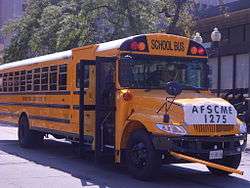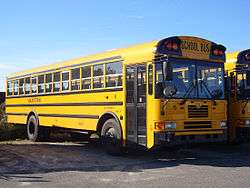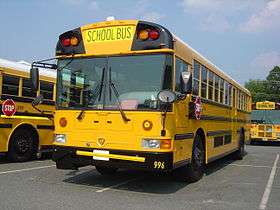IC Bus
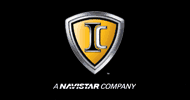 | |
Formerly | IC Corporation (Integrated Coach Corporation) |
|---|---|
| Subsidiary of Navistar International | |
| Industry | Manufacturing (Transportation) |
| Predecessor | |
| Founded | 2002 (as IC Corporation) |
| Headquarters |
2601 Navistar Dr Lisle, Illinois 60532 |
Number of locations |
2
|
Area served | North America |
Key people | John McKinney, President |
| Products |
|
| Parent | Navistar International |
| Website |
www |
IC Bus (originally IC Corporation) is an American bus manufacturer that produces yellow school buses and commercial-use buses (shuttle buses) primarily for the United States and Canada, with limited exports outside North America. Headquartered in Lisle, Illinois, IC is a wholly owned subsidiary of Navistar International. The company was established by Navistar in 2002 through a reorganization of its subsidiary bus manufacturer American Transportation Corporation (AmTran). Through AmTran, IC traces its roots back to the 1933 founding of Ward Body Works in Conway, Arkansas.
The IC company name stands for Integrated Coach, alluding to how the vehicles are nearly completely assembled under a single corporate structure. For all IC vehicles, Navistar produces the bus body and chassis, while engines are supplied by Cummins (diesel/CNG) and PSI (gasoline/propane). Currently, all IC Bus vehicles are produced at its manufacturing facility in Tulsa, Oklahoma; since 2010, the former AmTran/Ward manufacturing facility in Conway, Arkansas has remained in use for fabrication and the production of parts.
History
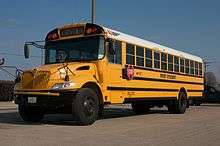
2000s: AmTran to IC
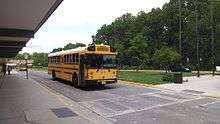
The transition of the bus manufacturing subsidiary of Navistar began in 2000 as AmTran introduced a new-generation cowled-chassis conventional. While still based upon the International 3800 and sharing much of the body with its AmTran Volunteer/CS predecessor, the new bus featured a redesigned drivers compartment and larger windshield. The new bus was given the International IC name (IC standing for Integrated Coach/Chassis), the model emphasized how the entire vehicle (body, chassis, engine) was produced under a single corporate entity. To distinguish the IC from other Type C buses sharing the International 3800 chassis, the IC was given its own grille and hood badging.
After 2000, AmTran Corporation changed its name to International Truck and Bus, bringing it in line with the truck manufacturing division of Navistar (then International Truck and Engine); the AmTran FE (Front Engine) and AmTran RE (Rear Engine) model lines adopted the International brand name and badging. For 2003, International re-branded its bus subsidiary to IC Corporation. After a minor update, the International IC was rebranded the IC CE-Series, in line with the FE and RE-Series buses.
In the mid-2000s, IC saw a number of changes. As Navistar introduced its first all-new cowled chassis since 1979 with the International 3300 (a cowled-chassis variant of the International 4300/Durastar), IC introduced a new-generation CE-Series in 2005. In 2006, the BE-Series was a second IC-bodied bus based on the 3300; although similar in configuration to the CE, the flat-floor low-profile BE was designed for users of smaller buses; its highest capacity was 30 passengers.
While the commercial products of Ward/AmTran had been strictly derived from variants of their school bus bodies, in 2006, IC launched two all-new product ranges for commercial, paratransit, and shuttle bus customers. In addition to commercial variants of the BE, CE, and RE, IC launched two cutaway-cab product lines based on the International Durastar. The HC-Series was a range of shuttle buses while the LC-Series was a low-floor bus aimed at paratransit customers.[1]
In April 2009, IC Corporation changed its name to IC Bus.
2010s: Product adaptation
2010 marked a major transition of the IC product line. In a single year, the company ended production of one of its highest-capacity vehicles while making an introduction of its first small school bus. The FE-Series was removed from the IC product line, as dealers announced its discontinuation in April and the company removed its product literature from the IC Bus website. Subsequently, the only Type D bus in the IC product line is the rear-engine RE-Series. The International TerraStar Class 4/5 truck formed the basis of two new model lines introduced by the company. The AC-Series was introduced as a commercial shuttle bus (competing against van-based buses),[2] while the AE-Series became the first cutaway-cab school bus produced by the company since the discontinuation of the AmTran Vanguard in 1996.[3]
In the mid-2010s, IC Bus underwent changes to stabilize its model line. To re-emphasize the ties to its parent company, IC Bus modified its branding in 2013, for the 2014 model year, adding the Navistar script to its IC Bus "wing" logo. To better focus on its core model lines, the AE/AC-Series, BE-Series, and LC-Series were discontinued in 2014. Currently (as of the 2017 model year), the CE and RE-Series school buses/MFSABs and commercial derivatives are produced alongside the HC-Series commercial shuttle bus (based on the Durastar truck).[4]
Navistar was the sole US-based diesel engine manufacturer to pursue the use of exhaust gas recirculation (EGR) to control diesel emissions rather than selective catalytic reduction (SCR), touting the advantage in overall fluid economy (measuring combined diesel + urea consumption),[5] although earlier tests showed a decided fuel economy advantage with SCR.[6] More stringent emissions controls caused bus prices to increase in 2010.[7] In response to the failure of the controversial EGR emissions strategy to meet emissions standards,[8] the MaxxForce engines were phased out in the CE-Series, with the Cummins ISB6.7 essentially taking the place of both previous diesel engines after being introduced as an option in 2013.[9][10] In 2015, IC debuted its first alternative-fuel vehicle, showing a propane-powered CE-Series with a PSI 8.8L V8 engine.[11] In 2016, the same engine was introduced in a gasoline-fueled configuration.[12] A Cummins L9 8.9L Diesel option was introduced for the RE Series for the 2017 model year, and a Cummins B6.7 option was added for the 2018 model year, replacing the defunct Maxxforce Diesel options.[13] Cummins is often confused as MaxxForce, but they are made by two different companies and have absolutely nothing to do with each other.
Products
School/commercial buses
- Model designations
Prior to 2010, IC used the following nomenclature (on school buses) to designate the engine type; subsequently, only the model prefix has been used.
| Diesel Engine Configuration | BE-Series | CE-Series | FE-Series | RE-Series |
|---|---|---|---|---|
| V8 | BE200 | CE200 | RE200 | |
| Inline-6 | CE300 | FE300 | RE300 |
| IC Bus Product Line (School Buses) | |||||||||||||||
|---|---|---|---|---|---|---|---|---|---|---|---|---|---|---|---|
| Model Name | Production Date | Assembly Location | Chassis Configuration
(Chassis Model) |
Vehicle type | Seating Capacity | Notes | |||||||||
| AE-Series AC-Series
|
2010–2015. AE 2015 only. | Tulsa, Oklahoma | Cutaway cab/chassis |
|
36 (AE-Series) 31 (AC-Series) |
| |||||||||
| BE-Series
|
2006–2015 | Cowled chassis |
|
up to 35 |
| ||||||||||
| CE-Series
|
2001–present | Cowled chassis
International 3800 (2001-2004) (2005–present) |
|
29-78 (school bus/MFSAB)
52 (commercial bus) |
| ||||||||||
| FE-Series
|
1998-2010 | Conway, Arkansas | Front-engine stripped chassis | School bus (Type D) |
54-90 |
| |||||||||
| RE-Series RC-Series
|
1996–present | Conway, Arkansas
|
Rear-engine stripped chassis |
|
|
| |||||||||
| IC Bus Product Line (Commercial Buses) | |||||||||||||||
| Model Name | Production Date | Assembly Location | Chassis Configuration
(Chassis Model) |
Vehicle Type | Seating Capacity | Notes | |||||||||
| LC-Series | 2006-2014 | Tulsa, Oklahoma | Cutaway cab/chassis | Low-floor shuttle bus |
| ||||||||||
| HC-Series
|
2006–present | Cutaway cab/chassis |
|
|
| ||||||||||
Future directions
Forward Advantage Prototype
The IC FE Forward Advantage was a school bus prototype built by IC in 2008 as a testbed of a "flat-floor" design in the stepwell due to the compact design of the Caterpillar C7 engine. It also included some front-end styling modifications influenced by the severe-service line of International trucks. As Caterpillar has withdrawn from producing diesel engines for the school bus market, the Forward Advantage will not see production in its current form since its design was tailored to the Caterpillar engine.
Hybrid diesel-electric buses
IC offers hybrid diesel-electric powertrains in the CE conventional school bus as an option. The buses provide a claimed approximately 40% to 65% better fuel economy[18][19] but cost about two and a half times more than a standard diesel bus ($210,000 versus $80,000).[20][21]
Enova Systems[22] entered into a long-term supply agreement with IC Bus[23] that guarantees that Enova's proprietary Post Transmission Parallel Hybrid Electric drive system will be used in IC Bus' hybrid electric school buses.[18] The hybrid school bus project features Enova's charge depleting (or "plug-in") or charge-sustaining systems. The drivetrain is powered by Valence Technology lithium ion phosphate battery modules. The braking system utilizes regenerative braking both as a means to reduce wear on the service brakes and to supply the batteries with extra power.[19]
Motorcoach prototypes
At the 2008 American Public Transportation Association Expo trade show, Navistar announced its intention to enter the intercity motorcoach segment by 2010, unveiling two prototypes produced by IC Bus.[24] Using the MaxxForce 13 powerplant, IC Bus produced a 40-foot long prototype alongside a 45-foot prototype. Using wind-tunnel design, the company predicted similar fuel-efficiency gains that were seen with the streamlined International ProStar semitractor.[24]
Following the two prototypes, IC Bus abandoned its efforts in the motorcoach segment, concentrating its commercial buses on school bus derivatives and the HC-Series (a cutaway variant of the International DuraStar).
Electric bus
On November 7, 2017, IC Bus announced the chargE, an all-electric CE Series bus delivering up to 260 kilowatts (350 hp) in power using a Volkswagen Truck & Bus Group-supplied common group electric drivetrain. It is the second electric vehicle to be delivered from the Navistar-Volkswagen alliance. The chargE is predicted to be available by 2019.[25]
Assembly
All IC Corporation/IC Bus vehicles are produced in the Tulsa, Oklahoma, facility opened by AmTran in 1999. Prior to 2008, Type D models were produced in the Ward/AmTran facility in Conway, Arkansas.
IC Corporation announced potential layoffs of up to 500 workers at the Conway plant (which employed approximately 1,000) in June 2007. Demand for school buses were affected by a price hike in the 2007 model year due to more stringent emissions regulations. School districts increased their purchases of the 2006 model year buses, which were $5,000 to $7,000 less than the 2007 model year buses, and the Conway plant was producing approximately 30 buses per day, down from 50 buses per day during the peak demand.[26] Although the company later announced no layoffs would occur in 2007,[27] the layoffs materialized on January 11, 2008, when IC Corporation announced a layoff of about 300 employees at the Conway, Arkansas Bus Plant.[28] This was just under the maximum proportion of employees that could be laid off in Conway without the company violating the WARN Act, which requires employers to give 60 days notice of a mass layoff or plant closing.[29] In addition to the layoffs, the company also announced a 50 percent reduction in bus production at the Conway plant. IC Corp. officials cited a lack of new orders as the reason for the layoffs.[26] However, the company had recently announced increased production at the plant in Tulsa, Oklahoma. This stoked fears in Conway that the company was planning to shut down the plant in the near future and move all production to the newer, and non-union, Tulsa plant.
170 more workers were laid off at the Conway plant in March 2009. At the time, production had slowed to 16 buses per day, and following the layoffs, "cancellation of a huge order" resulted in production dropping to 8 buses per day.[30] On November 5, 2009, IC Bus announced that its Conway plant would no longer assemble buses after January 18, 2010, projecting elimination of 477 jobs. The Conway facilities would serve as fabrication shops and manufacture parts, but would no longer produce complete buses. The company cited low demand by school districts and contractors during the recessionary economic climate in the United States.[31] "We have to consolidate our bus-assembly operations into one facility," Navistar spokesman Roy Wiley said. "Unfortunately for Conway, Tulsa is a much newer facility."[32] Navistar sold off the Conway property in 2014.[33]
On June 5, 2012, the Tulsa, Oklahoma IC Bus assembly plant produced its 100,000th vehicle.[34] Workers at the Tulsa plant joined the United Auto Workers in 2013.[35] The Conway property was acquired by DBG Canada Ltd., a manufacturer of parts for the heavy truck industry, in 2017, and DBG announced it would make Conway its United States headquarters.[36]
See also
- AmTran - corporate predecessor
- Navistar International - parent company
References
- ↑ "IC Corporation Expands Beyond School Buses to Include New Commercial Bus Line; Five New Commercial Bus Models Launched" (Press release). Navistar. 7 June 2006. Retrieved 3 January 2018.
- ↑ "Navistar's IC Bus Launches All-New Small Shuttle Bus" (Press release). Navistar. 28 September 2010. Retrieved 3 January 2018.
- ↑ "Navistar's IC Bus Launches AE Series, School Bus Industry's First Integrated Type A School Bus. The AE was actually only built for one model year" (Press release). Navistar. 1 November 2010. Retrieved 3 January 2018.
- 1 2 3 "ICBus - IC Bus - Leading School Bus Manufacturer". IC Bus. Retrieved 2016-03-09.
- ↑ "Navistar's IC Bus Beats Competition in Fluid Economy" (Press release). Navistar. 16 June 2009. Retrieved 3 January 2018.
- ↑ Fuel Economy Comparison: Thomas Built bus with Cummins ISB, IC bus with MaxxForce 7 (PDF) (Report). Thomas Built bus. August 3–7, 2009. Retrieved 3 January 2018.
- ↑ "IC Bus on Track with 2010 Engines; Bus Prices to Increase $6,000" (Press release). Navistar. 16 June 2009. Retrieved 3 January 2018.
- ↑ "Order instituting cease-and-desist proceedings purusuant to Section 8A of the Securities Act of 1933 and Section 21C of the Securities Exchange Act of 1934, making findings, and imposing a cease-and-desist order" (PDF). Securities and Exchange Commission. 31 March 2016. Retrieved 3 January 2018.
- ↑ "Power Partners". IC Bus. Retrieved 3 January 2018.
- ↑ "Navistar's IC Bus Unveils First CE Series School Bus With Cummins ISB" (Press release). Navistar. 22 October 2013. Retrieved 3 January 2018.
- ↑ Fisher, Michelle (1 September 2014). "IC Bus Introducing Propane CE Series School Bus by Fall 2015". Stnonline.com. Retrieved 2016-03-09.
- ↑ McMahon, Thomas (25 July 2016). "IC Bus Unveils Gasoline-Powered Type C School Bus". School Bus Fleet. Retrieved 11 September 2016.
- ↑ Gray, Ryan (21 July 2016). "IC Bus introduces RE Series school bus with Cummins L9". School Transportation News. Retrieved 3 January 2017.
- ↑ "AE Series School Route Bus". Archived from the original on July 13, 2011. Retrieved November 6, 2010.
- ↑ "BE Series School Route Bus". IC Bus. Archived from the original on 31 December 2010. Retrieved 3 January 2018.
- ↑ "CE Series" (PDF). IC Bus. 24 February 2016. Retrieved 3 January 2018.
- ↑ "IC Bus Helps Emeryville, California Go Green With New Hybrid Commercial Buses" (Press release). Navistar. 12 May 2009. Retrieved 3 January 2018.
- 1 2 "California's Newest Green Product - A Hybrid School Bus - Saves Fuel, Reduces Emissions" (Press release). Navistar. 25 July 2008. Retrieved 3 January 2018.
After one school year and 13,000 miles, [Ralph Knight, transportation director at Napa Valley School District] was pleasantly surprised to learn that the fuel efficiency of the hybrid bus helped him reach close to 13 miles per gallon -- nearly double the fuel efficiency of a typical diesel school bus. [...] Traveling about 65 miles per day, the hybrid bus typically transports roughly 60 children each morning and 60 each afternoon through a mixed route of highway and city driving.
- 1 2 "CE Series Hybrid Sell Sheet" (PDF). IC Bus. 2009. Archived from the original (PDF) on December 31, 2010. Retrieved April 26, 2010.
- ↑ "Plug-in Hybrid Electric School Bus, Project Phases - Phase IV". Advanced Energy. 29 September 2007. Archived from the original on September 29, 2007. Retrieved February 19, 2017.
- ↑ "Third and Fourth Graders Win Hybrid Bus for Their School as Nation Selects 'America's Greenest School" (Press release). Business Wire. 27 April 2010. Retrieved 3 January 2018.
- ↑ "Enova | Electric, Hybrid Electric and Fuel Cell Drive Systems". Enovasystems.com. 2011-12-31. Retrieved 2016-03-09.
- ↑ "Enova Systems and IC Bus Execute Long Term Agreement For Hybrid School Buses". Green Car Congress. 2008-05-20. Retrieved 2016-03-09.
- 1 2 "IC Bus Announces Plans to Enter Motorcoach Market in 2010 (NYSE:NAV)". Navistar (Press release). 6 October 2008. Retrieved 2016-09-26.
- ↑ "IC Bus unveils IC electric bus chargE(TM), its all-new electric school bus" (Press release). Navistar. 7 November 2017. Retrieved 3 January 2018.
- 1 2 Lamb, Joe (21 July 2007). "Layoffs still a possibility for IC Corp". Log Cabin Democrat. Archived from the original on 2018-01-04. Retrieved 3 January 2018.
- ↑ Dickerson, Rachel Parker (21 September 2007). "Layoffs not expected at IC Corp". Log Cabin Democrat. Archived from the original on 2018-01-04. Retrieved 3 January 2018.
- ↑ "Conway school-bus maker to lay off 300". Arkansasonline.com. 2008-01-11. Archived from the original on 22 April 2008. Retrieved 2016-03-09.
- ↑ Dickerson, Rachel Parker (12 January 2008). "IC Corporation's parent company announces layoffs". Log Cabin Democrat. Archived from the original on 2018-01-04. Retrieved 3 January 2018.
- ↑ Dickerson, Rachel Parker (26 March 2009). "IC Corp layoffs total 170". Log Cabin Democrats. Archived from the original on 2018-01-04. Retrieved 3 January 2018.
- ↑
- ↑ "Plant to stop bus making; up to 477 jobs affected". Arkansas Online. The Associated Press. 5 November 2009. Retrieved 3 January 2018.
- ↑ Corbet, Michelle (19 May 2014). "IC Bus property sells for $1.8M". Log Cabin Democrats. Retrieved 3 January 2018.
- ↑ "Navistar Celebrates 100,000th Bus Milestone (NYSE:NAV)". Ir.navistar.com. 2012-06-05. Retrieved 2016-03-09.
- ↑ Arnold, Kyle (19 February 2013). "IC Bus workers to unionize with United Auto Workers". Tulsa World. Retrieved 3 January 2018.
- ↑ Wilson, Kristen (2 August 2017). "DBG acquires former Conway operation for U.S. headquarters". KATV Little Rock. Retrieved 3 January 2018.
External links
- ICBus.com - official company web site

- "The RE Series School Bus" (PDF). National Bus. 2010. Retrieved 3 January 2018.

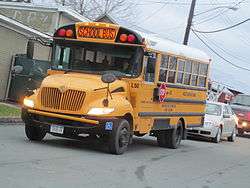
.jpg)
